数字信号处理课后答案第5章
- 格式:ppt
- 大小:1.54 MB
- 文档页数:75
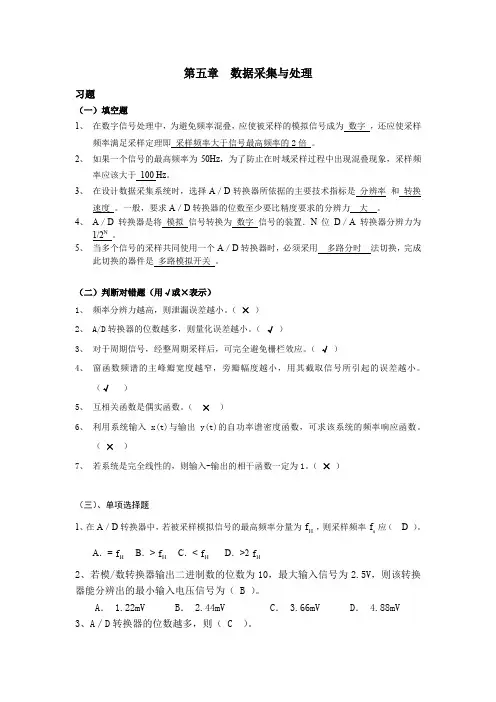
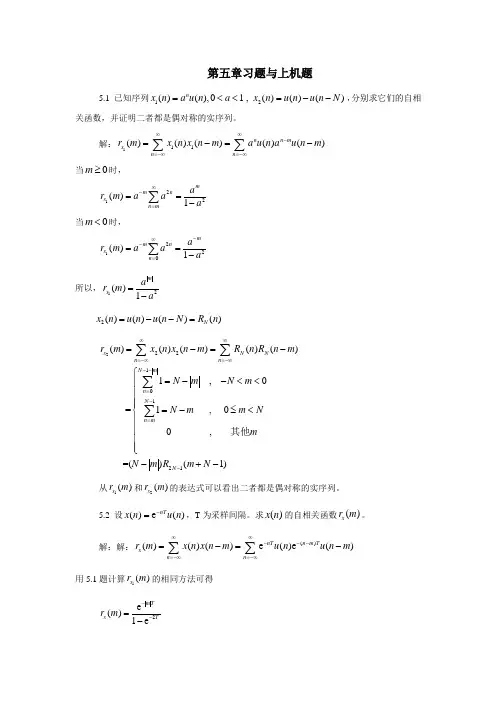
第五章习题与上机题5.1 已知序列12()(),0 1 , ()()()nx n a u n a x n u n u n N =<<=--,分别求它们的自相关函数,并证明二者都是偶对称的实序列。
解:111()()()()()nn mx n n r m x n x n m a u n au n m ∞∞-=-∞=-∞=-=-∑∑当0m ≥时,122()1mmnx n ma r m aaa∞-===-∑ 当0m <时,122()1m mnx n a r m aaa -∞-===-∑ 所以,12()1mx ar m a =-2 ()()()()N x n u n u n N R n =--=22210121()()()()()1,0 =1,00, =()(1)x NN n n N mn N n m N r m x n x n m Rn R n m N m N m N m m Nm N m R m N ∞∞=-∞=-∞--=-=-=-=-⎧=--<<⎪⎪⎪⎪=-≤<⎨⎪⎪⎪⎪⎩-+-∑∑∑∑其他从1()x r m 和2()x r m 的表达式可以看出二者都是偶对称的实序列。
5.2 设()e()nTx n u n -=,T 为采样间隔。
求()x n 的自相关函数()x r m 。
解:解:()()()()e()e ()nTn m T x n n r m x n x n m u n u n m ∞∞---=-∞=-∞=-=-∑∑用5.1题计算1()x r m 的相同方法可得2e()1e m Tx Tr m --=-5.3 已知12()sin(2)sin(2)s s x n A f nT B f nT ππ=+,其中12,,,A B f f 均为常数。
求()x n 的自相关函数()x r m 。
解:解:()x n 可表为)()()(n v n u n x +=的形式,其中)2sin()(11s nT f A n u π=,=)(n v 22sin(2)s A f nT π,)(),(n v n u 的周期分别为 s T f N 111=,sT f N 221=,()x n 的周期N 则是21,N N 的最小公倍数。

数字信号处理教程课后习题答案目录第一章离散时间信号与系统第二章Z变换第三章离散傅立叶变换第四章快速傅立叶变换第五章数字滤波器的基本结构第六章无限长单位冲激响应(IIR)数字滤波器的设计方法第七章有限长单位冲激响应(FIR)数字滤波器的设计方法第八章数字信号处理中有限字长效应第一章 离散时间信号与系统1 .直接计算下面两个序列的卷积和)n (h *)n (x )n (y =请用公式表示。
分析:①注意卷积和公式中求和式中是哑变量m ( n 看作参量), 结果)(n y 中变量是 n ,; )()()()()(∑∑∞-∞=∞-∞=-=-=m m m n x m h m n h m x n y ②分为四步 (1)翻褶( -m ),(2)移位( n ),(3)相乘,; )( )( 4n y n n y n 值的,如此可求得所有值的)相加,求得一个(③ 围的不同的不同时间段上求和范一定要注意某些题中在 n00 , 01()0 , ,()0,n n n a n N h n n n n x n n n β-⎧≤≤-=⎨⎩⎧≤⎪=⎨<⎪⎩其他如此题所示,因而要分段求解。
)(5.0)(,)1(2 )()4()(5.0)(,)2( )()3()()(,)( )()2()()(,)( )()1(3435n u n h n u n x n R n h n n x n R n h n R n x n R n h n n x n n n =--==-=====δδ2 .已知线性移不变系统的输入为)n (x ,系统的单位抽样响应 为)n (h ,试求系统的输出)n (y ,并画图。
分析:①如果是因果序列)(n y 可表示成)(n y ={)0(y ,)1(y ,)2(y ……},例如小题(2)为)(n y ={1,2,3,3,2,1} ;②)()(*)( , )()(*)(m n x n x m n n x n x n -=-=δδ ;③卷积和求解时,n 的分段处理。
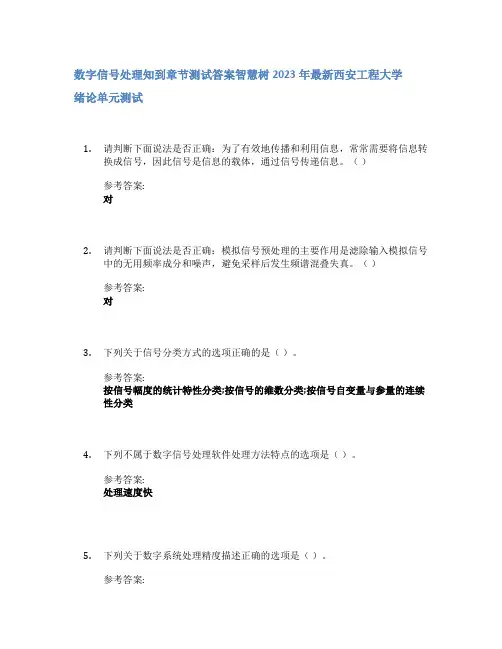
数字信号处理知到章节测试答案智慧树2023年最新西安工程大学绪论单元测试1.请判断下面说法是否正确:为了有效地传播和利用信息,常常需要将信息转换成信号,因此信号是信息的载体,通过信号传递信息。
()参考答案:对2.请判断下面说法是否正确:模拟信号预处理的主要作用是滤除输入模拟信号中的无用频率成分和噪声,避免采样后发生频谱混叠失真。
()参考答案:对3.下列关于信号分类方式的选项正确的是()。
参考答案:按信号幅度的统计特性分类;按信号的维数分类;按信号自变量与参量的连续性分类4.下列不属于数字信号处理软件处理方法特点的选项是()。
参考答案:处理速度快5.下列关于数字系统处理精度描述正确的选项是()。
参考答案:精度由系统字长与算法决定第一章测试1.请判断下面说法是否正确:时域离散信号通过量化编码转换为数字信号,是一种无损变换。
( )参考答案:错2.下列信号是周期信号的有()。
参考答案:;;3.信号的最小周期是()。
参考答案:24.请判断下面说法是否正确:线性时不变时域离散系统具有线性性质和时不变特性。
()参考答案:对5.以下序列是系统的单位脉冲响应h(n),则是稳定系统的有()。
参考答案:;第二章测试1.请判断下面说法是否正确:时域离散信号和系统分析可以通过傅里叶变换和Z变换两种数学工具()。
参考答案:对2.请判断下面说法是否正确:周期序列的傅里叶变换以为周期,而且一个周期内只有N个冲激函数表示的谱线()。
参考答案:错3.实序列的傅里叶变换具有()。
参考答案:共轭对称性质4.已知序列,其Z变换和收敛域为()。
参考答案:;5.序列,其傅里叶变换为()。
参考答案:第三章测试1.在变换区间0≤n≤N-1内,序列的N点DFT在k=0的值为()。
参考答案:N2.在变换区间0≤n≤N-1内,序列的N点DFT的值为()参考答案:13.已知,求=()参考答案:1/N4.已知,求=()参考答案:5.已知,求=()参考答案:第四章测试1.请判断下面说法是否正确:模拟信号数字处理中,模拟信号与数字信号之间的相互转换中要求不能丢失有用信息()。
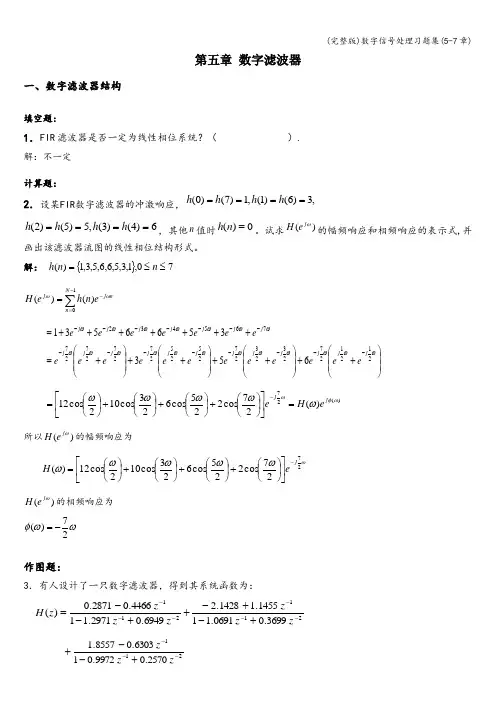
第五章 数字滤波器一、数字滤波器结构填空题:1.FIR 滤波器是否一定为线性相位系统?( ).解:不一定计算题:2.设某FIR 数字滤波器的冲激响应,,3)6()1(,1)7()0(====h h h h6)4()3(,5)5()2(====h h h h ,其他n 值时0)(=n h 。
试求)(ωj e H 的幅频响应和相频响应的表示式,并画出该滤波器流图的线性相位结构形式。
解: {}70,1,3,5,6,6,5,3,1)(≤≤=n n h ∑-=-=10)()(N n nj j e n h e H ωω⎪⎪⎭⎫ ⎝⎛++⎪⎪⎭⎫ ⎝⎛++⎪⎪⎭⎫ ⎝⎛++⎪⎪⎭⎫ ⎝⎛+=+++++++=---------------ωωωωωωωωωωωωωωωωωωω2121272323272525272727277654326533566531j j j j j j j j j j j j j j j j j j j e e e e e e e e e e e ee e e e e e e )(27)(27cos 225cos 623cos 102cos 12ωφωωωωωωj j e H e=⎥⎦⎤⎢⎣⎡⎪⎭⎫ ⎝⎛+⎪⎭⎫ ⎝⎛+⎪⎭⎫ ⎝⎛+⎪⎭⎫ ⎝⎛=- 所以)(ωj e H 的幅频响应为ωωωωωω2727cos 225cos 623cos 102cos 12)(j eH -⎥⎦⎤⎢⎣⎡⎪⎭⎫ ⎝⎛+⎪⎭⎫ ⎝⎛+⎪⎭⎫ ⎝⎛+⎪⎭⎫ ⎝⎛= )(ωj e H 的相频响应为ωωφ27)(-=作图题:3.有人设计了一只数字滤波器,得到其系统函数为:2112113699.00691.111455.11428.26949.02971.114466.02871.0)(------+-+-++--=z z z z z z z H 2112570.09972.016303.08557.1---+--+z z z请采用并联型结构实现该系统。
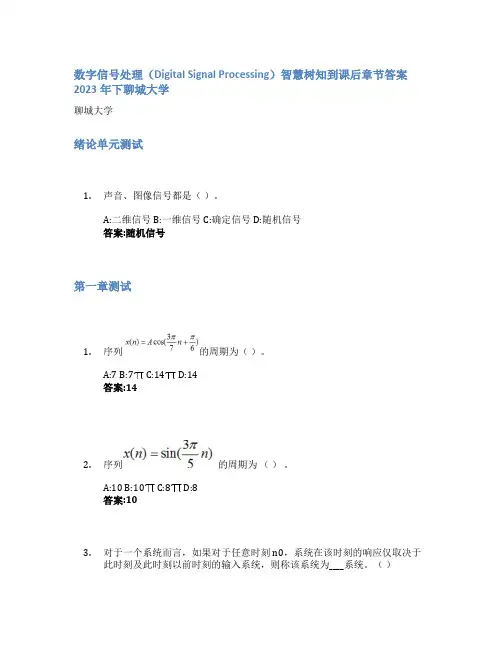
数字信号处理(Digital Signal Processing)智慧树知到课后章节答案2023年下聊城大学聊城大学绪论单元测试1.声音、图像信号都是()。
A:二维信号 B:一维信号 C:确定信号 D:随机信号答案:随机信号第一章测试1.序列的周期为()。
A:7 B:7 C:14 D:14答案:142.序列的周期为()。
A:10 B:10 C:8 D:8答案:103.对于一个系统而言,如果对于任意时刻n0,系统在该时刻的响应仅取决于此时刻及此时刻以前时刻的输入系统,则称该系统为____系统。
()A:线性 B:因果 C:稳定 D:非线性答案:因果4.线性移不变系统是因果系统的充分必要条件是______。
()A:n<0,h(n)=0 B:n>0,h(n)=0 C:n>0,h(n)>0 D:n<0,h(n)>0答案:n<0,h(n)=05.要想抽样后能够不失真的还原出原信号,则抽样频率必须,这就是奈奎斯特抽样定理。
()A:等于2倍fm B:小于等于2倍fm C:大于2倍fm D:大于等于2倍fm答案:大于等于2倍fm6.已知x(n)=δ(n),其N点的DFT[x(n)]=X(k),则X(N-1)= 1。
()A:对 B:错答案:对7.相同的Z变换表达式一定对应相同的时间序列。
()A:对 B:错答案:错8.滤波器设计本质上是用一个关于z的有理函数在单位圆上的特性来逼近所有要求的系统频率特性。
()A:错 B:对答案:对9.下面描述中最适合离散傅立叶变换DFT的是()A:时域为离散周期序列,频域也为离散周期序列 B:时域为离散有限长序列,频域也为离散有限长序列 C:时域为离散序列,频域也为离散序列 D:时域为离散无限长序列,频域为连续周期信号答案:时域为离散有限长序列,频域也为离散有限长序列10.巴特沃思滤波器的幅度特性必在一个频带中(通带或阻带)具有等波纹特性。
()A:错 B:对答案:错第二章测试1.N=1024点的DFT,需要复数相乘次数约()。
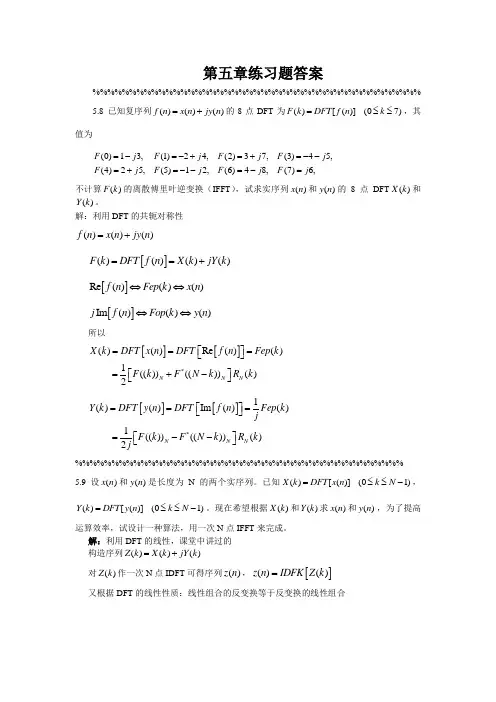
第五章练习题答案%%%%%%%%%%%%%%%%%%%%%%%%%%%%%%%%%%%%%%%%%%%%%5.8 已知复序列()()()f n x n jy n =+的8点DFT 为()[()](07)F k DFT f n k =≤≤,其值为(0)13,(1)24,(2)37,(3)45,(4)25,(5)12,(6)48,(7)6,F j F j F j F j F j F j F j F j =-=-+=+=--=+=--=-=不计算()F k 的离散傅里叶逆变换(IFFT ),试求实序列()x n 和()y n 的8点DFT ()X k 和()Y k 。
解:利用DFT 的共轭对称性()()()f n x n jy n =+[]()()()()F k DFT f n X k jY k ==+[]Re ()()()f n Fep k x n ⇔⇔[]Im ()()()j f n Fop k y n ⇔⇔所以[][]*()()R e ()()1(())(())()2N N N X k D FT x n D FT f n Fep k F k F N k R k ⎡⎤===⎣⎦⎡⎤=+-⎣⎦ [][]*1()()Im ()()1(())(())()2N N N Y k D FT y n D FT f n Fep k j F k F N k R k j ⎡⎤===⎣⎦⎡⎤=--⎣⎦%%%%%%%%%%%%%%%%%%%%%%%%%%%%%%%%%%%%%%%%%%%%%5.9 设()x n 和()y n 是长度为N 的两个实序列。
已知()[()](01)X k DFT x n k N =≤≤-,()[()](01)Y k DFT y n k N =≤≤-。
现在希望根据()X k 和()Y k 求()x n 和()y n ,为了提高运算效率,试设计一种算法,用一次N 点IFFT 来完成。
解:利用DFT 的线性,课堂中讲过的构造序列()()()Z k X k jY k =+对()Z k 作一次N 点IDFT 可得序列()z n ,[]()()z n IDFK Z k =又根据DFT 的线性性质:线性组合的反变换等于反变换的线性组合[][][][]()()()()()()()()z n ID FT Z k ID FT X k jY k ID FT X k jID FT Y k x n jy n ==+=+=+而()x n ,()y n 都是实序列()Re(())x n z n =()Im(())y n z n =。


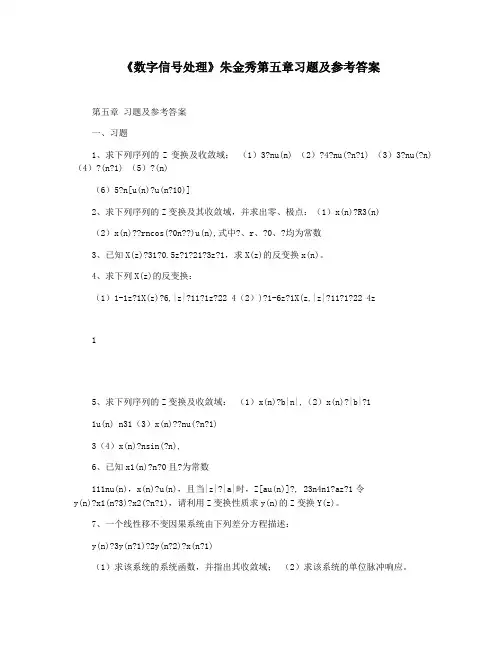
《数字信号处理》朱金秀第五章习题及参考答案第五章习题及参考答案一、习题1、求下列序列的Z变换及收敛域:(1)3?nu(n) (2)?4?nu(?n?1) (3)3?nu(?n) (4)?(n?1) (5)?(n)(6)5?n[u(n)?u(n?10)]2、求下列序列的Z变换及其收敛域,并求出零、极点:(1)x(n)?R3(n)(2)x(n)??rncos(?0n??)u(n),式中?、r、?0、?均为常数3、已知X(z)?31?0.5z?1?21?3z?1,求X(z)的反变换x(n)。
4、求下列X(z)的反变换:(1)1-1z?1X(z)?6,|z|?11?1z?22 4(2))?1-6z?1X(z,|z|?11?1?22 4z15、求下列序列的Z变换及收敛域:(1)x(n)?b|n|,(2)x(n)?|b|?11u(n) n31(3)x(n)??nu(?n?1)3(4)x(n)?nsin(?n),6、已知x1(n)?n?0且?为常数111nu(n),x(n)?u(n),且当|z|?|a|时,Z[au(n)]?, 23n4n1?az?1令y(n)?x1(n?3)?x2(?n?1),请利用Z变换性质求y(n)的Z变换Y(z)。
7、一个线性移不变因果系统由下列差分方程描述:y(n)?3y(n?1)?2y(n?2)?x(n?1)(1)求该系统的系统函数,并指出其收敛域;(2)求该系统的单位脉冲响应。
8、设系统由下列差分方程描述: y(n)?y(n?1)?y(n?2)?x(n)(1)求系统函数H(z),并求出零、极点;(2)若限定系统是因果的,写出H(z)的收敛域,并求出单位脉冲响应h(n);(3)若限定系统是稳定的,写出H(z)的收敛域,并求出单位脉冲响应h(n)。
2529、用MATLAB实现长除法,计算下列X(z)的Z反变换(取10个点):1?1z12(1)X(z)?,|z|?121?z?1411?z?13(2)X(z)?,|z|?3 ?1?21?6z?9z1?10、已知X(z)?11、已知X(z)?换。
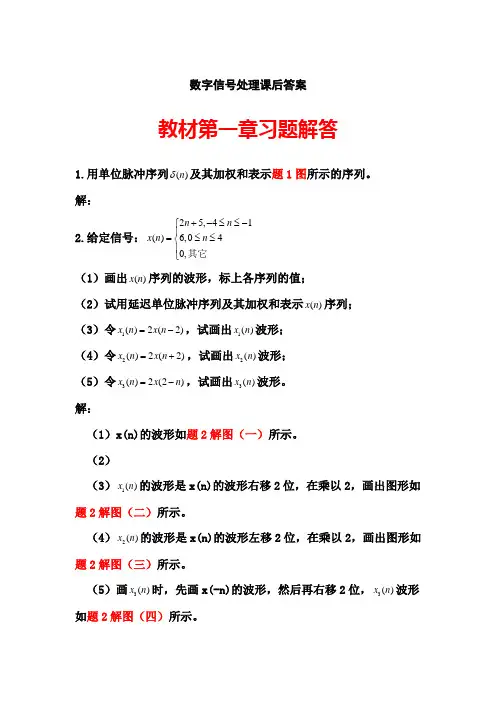
数字信号处理课后答案教材第一章习题解答1.用单位脉冲序列()nδ及其加权和表示题1图所示的序列。
解:2.给定信号:25,41 ()6,040,n nx n n+-≤≤-⎧⎪=≤≤⎨⎪⎩其它(1)画出()x n序列的波形,标上各序列的值;(2)试用延迟单位脉冲序列及其加权和表示()x n序列;(3)令1()2(2)x n x n=-,试画出1()x n波形;(4)令2()2(2)x n x n=+,试画出2()x n波形;(5)令3()2(2)x n x n=-,试画出3()x n波形。
解:(1)x(n)的波形如题2解图(一)所示。
(2)(3)1()x n的波形是x(n)的波形右移2位,在乘以2,画出图形如题2解图(二)所示。
(4)2()x n的波形是x(n)的波形左移2位,在乘以2,画出图形如题2解图(三)所示。
(5)画3()x n时,先画x(-n)的波形,然后再右移2位,3()x n波形如题2解图(四)所示。
3.判断下面的序列是否是周期的,若是周期的,确定其周期。
(1)3()cos()78x n A n ππ=-,A 是常数;(2)1()8()j n x n e π-=。
解:(1)3214,73w w ππ==,这是有理数,因此是周期序列,周期是T=14;(2)12,168w wππ==,这是无理数,因此是非周期序列。
5.设系统分别用下面的差分方程描述,()x n 与()y n 分别表示系统输入和输出,判断系统是否是线性非时变的。
(1)()()2(1)3(2)y n x n x n x n =+-+-; (3)0()()y n x n n =-,0n 为整常数; (5)2()()y n x n =; (7)0()()nm y n x m ==∑。
解:(1)令:输入为0()x n n -,输出为'000'0000()()2(1)3(2)()()2(1)3(2)()y n x n n x n n x n n y n n x n n x n n x n n y n =-+--+---=-+--+--=故该系统是时不变系统。
数字信号处理知到章节测试答案智慧树2023年最新上海健康医学院第一章测试1.如果连续时间信号是最高截止频率为的带限信号,采样频率为_______可不失真地恢复原连续时间信号。
参考答案:2.由模拟信号采样得到的序列,模拟角频率Ω与序列的数字域频率参考答案:线性3.在连续系统中,正弦信号是周期信号,其周期与频率呈_______关系。
参考答案:2π/w4.在离散时间系统中,最常用的是_______。
参考答案:线性非移变系统5.线性非移变系统的性质不包括_______。
参考答案:0-1 率6.由于序列是离散的,故在序列运算中不存在微积分运算。
()参考答案:对7.采样频率太高会产生太大的数据量,使运算时间延长,设备成本增加。
()参考答案:对8.系统满足可加性或齐次性,即为线性系统。
()参考答案:错9.任何序列都可以表示成单位脉冲序列移位加权和的形式。
()参考答案:对10.两个线性非移变系统级联后构成一个线性移变系统。
()参考答案:错第二章测试1.Z 变换是从_______直接引申出来的一种变换方法。
参考答案:拉普拉斯2.当序列是一个()序列时,双边Z变换和单边Z变换是相等的。
参考答案:因果3.Z 变换是关于 Z 的无穷多项的幂级数的_______。
参考答案:和4.的Z变换是_______。
参考答案:5.的 Z 变换收敛域是_______。
参考答案:|z|>|a|6.Z 变换等价于序列的傅里叶变换。
()参考答案:错7.收敛域包含∞是因果序列的Z变换得特征。
参考答案:对8.根据序列的 Z 变换求对应序列的运算称之为逆 Z 变换。
()参考答案:错9.的Z变换等于1。
参考答案:对10.对于求解同样的逆 Z 变换,因选择的方法不同,得到结果序列的分段点不同,实际数值上二者是等价的。
()参考答案:对第三章测试1.时域的连续周期对应于频域的()。
参考答案:非周期离散2.序列x1(n)的长度为4,序列x2(n)的长度为3,则它们线性卷积的长度是(),5点圆周卷积的长度是()。
第一章 离散时间信号与系统2.任意序列x(n)与δ(n)线性卷积都等于序列本身x(n),与δ(n-n 0)卷积x(n- n 0),所以(1)结果为h(n) (3)结果h(n-2) (2(4)3 .已知 10,)1()(<<--=-a n u a n h n,通过直接计算卷积和的办法,试确定单位抽样响应为 )(n h 的线性移不变系统的阶跃响应。
4. 判断下列每个序列是否是周期性的,若是周期性的,试确定其周期:)6()( )( )n 313si n()( )()873cos()( )(ππππ-==-=n j e n x c A n x b n A n x a分析:序列为)cos()(0ψω+=n A n x 或)sin()(0ψω+=n A n x 时,不一定是周期序列,nmm m n n y n - - -∞ = - ⋅ = = ≥ ∑ 2 31 2 5 . 0 ) ( 01当 3 4n m nm m n n y n 2 2 5 . 0 ) ( 1⋅ = = - ≤ ∑ -∞ = - 当 aa a n y n a a an y n n h n x n y a n u a n h n u n x m m nnm mn -==->-==-≤=<<--==∑∑--∞=---∞=--1)(11)(1)(*)()(10,)1()()()(:1时当时当解①当=0/2ωπ整数,则周期为0/2ωπ;②;为为互素的整数)则周期、(有理数当 , 2 0Q Q P QP =ωπ ③当=0/2ωπ无理数 ,则)(n x 不是周期序列。
解:(1)0142/3πω=,周期为14 (2)062/13πω=,周期为6 (2)02/12πωπ=,不是周期的 7.(1)[][]12121212()()()()()()[()()]()()()()[()][()]T x n g n x n T ax n bx n g n ax n bx n g n ax n g n bx n aT x n bT x n =+=+=⨯+⨯=+所以是线性的T[x(n-m)]=g(n)x(n-m) y(n-m)=g(n-m)x(n-m) 两者不相等,所以是移变的y(n)=g(n)x(n) y 和x 括号内相等,所以是因果的。
数字信号处理课后答案1.2 教材第一章习题解答1. 用单位脉冲序列()n δ及其加权和表示题1图所示的序列。
解:()(4)2(2)(1)2()(1)2(2)4(3) 0.5(4)2(6)x n n n n n n n n n n δδδδδδδδδ=+++-+++-+-+-+-+-2. 给定信号:25,41()6,040,n n x n n +-≤≤-⎧⎪=≤≤⎨⎪⎩其它(1)画出()x n 序列的波形,标上各序列的值;(2)试用延迟单位脉冲序列及其加权和表示()x n 序列; (3)令1()2(2)x n x n =-,试画出1()x n 波形; (4)令2()2(2)x n x n =+,试画出2()x n 波形; (5)令3()2(2)x n x n =-,试画出3()x n 波形。
解:(1)x(n)的波形如题2解图(一)所示。
(2)()3(4)(3)(2)3(1)6() 6(1)6(2)6(3)6(4)x n n n n n n n n n n δδδδδδδδδ=-+-+++++++-+-+-+-(3)1()x n 的波形是x(n)的波形右移2位,在乘以2,画出图形如题2解图(二)所示。
(4)2()x n 的波形是x(n)的波形左移2位,在乘以2,画出图形如题2解图(三)所示。
(5)画3()x n 时,先画x(-n)的波形,然后再右移2位,3()x n 波形如题2解图(四)所示。
3. 判断下面的序列是否是周期的,若是周期的,确定其周期。
(1)3()cos()78x n A n ππ=-,A 是常数;(2)1()8()j n x n e π-=。
解:(1)3214,73w w ππ==,这是有理数,因此是周期序列,周期是T=14; (2)12,168w wππ==,这是无理数,因此是非周期序列。
5. 设系统分别用下面的差分方程描述,()x n 与()y n 分别表示系统输入和输出,判断系统是否是线性非时变的。
5-1 An AM broadcast transmitter is tested by feeding the RF output into a 50-Ω (dummy) load. Tone modulation is applied. The carrier frequency is 850 kHz and the FCC licensed power output is 5,000 W. The sinusoidal tone of 1,000 Hz is set for 90% modulation.(a) Evaluate the FCC power in dBk (dB above 1 kW) units.(b) Write an equation for the voltage that appears across the 50-Ω load, giving numerical values for all constants.(c) Sketch the spectrum of this voltage as it would appear on a calibrated spectrum analyzer.(d) What is the average power that is being dissipated in the dummy load? (e) What is the peak envelope power? Solution :(a) FCC power:500010lg 6.99()1000dBK ⎛⎫= ⎪⎝⎭()()()():c o s 20001000900.9501cos m m m c c b Let m t A t f H z A s t A m t tπω==→=∴Ω=+⎡⎤⎣⎦是%调制负载上通过的电压为:()707[10.9 cos (2000)]cos[2850,000]s t t t ππ=+(c)])cos[(2)707(9.0])cos[(2)707(9.0cos 707)(t t t t s m c m c c ωωωωω++-+=212500050c A =707c A V=(d)50Ω负载上的平均功率:()222A V G real 210.921505020.95000170252c A st P w<>⎡⎤==+⎢⎥⎣⎦⎡⎤=+=⎢⎥⎣⎦(e) (){}[]222PEP P 1max 500010.918050250cA m t w =+=⨯+=⎡⎤⎣⎦⨯5-2 An AM transmitter is modulated with an audio testing signal given by()120.2sin 0.5cos m t t t ωω=+, where 1500f Hz =,2f =,and 100c A =.Assume that the AM signal is fed into a 50Ω load. (a) Sketch the AM waveform. (b) What is the modulation percentage?(c) Evaluate and sketch the spectrum of the AM waveform. Solution: ()()12100(10.2sin 0.5cos )cos c a s t t t t ωωω=++2222221110.9()()12222c c cs t A A m t A ⎡⎤<>=+<>=+⎢⎥⎣⎦5-4 Assume that an AM transmitter is modulated with a video testing signal given by ()10.20.6sin m t t ω=-+,where f 1=3.57MHz. Let A c =100. (a) Sketch the AM waveform.(b) What are the percentages of positive and negative modulation? (c) Evaluate and sketch the spectrum of the AM waveform about f c .Solution:()()()()()()1110.20.6sin 3.57;1001001cos 1000.80.6sin cos m c c c a m t t f f M H zA s t m t t t tωωωω=-+====+=+()m ax m in140100%pos.m od.40%10010020%neg.m od.80%100ccc cA A b A A A A --===--===()()()()()04015c c m c m c f Sff f j f f f f f f δδδ>=------+⎡⎤⎣⎦5-5 A 50,000-W AM broadcast transmitter is being evaluated by means of a two-tonetest.The transmitteris connected to a 50-Ω load, and()1111cos cos 2m t A t A t ωω=+, where f 1=500 Hz. Assume that a perfect AMsignal is generated.(a) Evaluate the complex envelope for the AM signal in terms of A 1 and ω1. (b) Determine the value of A 1 for 90% modulation.(c) Find the values for the peak current and average current into the 50-Ω load for the 90% modulation case. Solution:(a))]2cos (cos 1[2236)](1[)(V2236)50(2000,501112t t A t m A t g A A C c cωω++=+==⇒=(b)()1111111cos 2c c os 2os []cos A t t m t A t A t ωωωω=++=to find [m (t )]min : x (θ) = cos θ +cos2θ()sin 2sin 20dx d θθθθ=--=sin 4sin cos θθθ-=125.1)5.104(5.104-=︒︒=x θ()()()111min 104.51.12min 0.905.8om t A m A x At -=→=⎡==-⎡⎤⎣⎤⎣⎦⎦m ax 1M I N 1m ax m in112236[12]2236[1 1.125]3.1250.900.57622cA A A A A A A A A =+=--==⇒=另解:(c)m ax m ax m ax m ps1112236[12(0.8)]5813.6volts116.272 50()2236[10.8(cos cos 2)]cos 0 Av c c A A I A I s t t t tfor ωωωωω=+=====++⋅=>>m ax m ax m ax m ps1112236[12(0.576)]4811.9volts96.238 50()2236[10.576(cos cos 2)]cos 0 c c A A I A s t t t tfor ωωωωω=+====++⋅=>>另解:∴ mps A 0I Av =5-12 SSB signals can be generated by the phasing method shown in Fig. 5-5a, by the filter method, of Fig. 5-5b, or by the use of Weaver ’s method [Weaver, 1956], as shown in Fig. P5-12. For Weaver ’s method (Fig. P5-12), where B is the bandwidth of m (t ),(a) Find a mathematical expression that describes the waveform out of each block on the block diagram.(b) Show that s (t) is an SSB signal.Figure P5-12 Weaver ’s method for generating SSB.Solution:)cos(212cos )(1Bt t B t V ππ=⎪⎪⎭⎫⎝⎛⎪⎭⎫ ⎝⎛=⎥⎦⎤⎢⎣⎡++-=↔==)21()21(21)()cos()()()()(313B f M B f M f V Bt t m t V t m t V π⎥⎦⎤⎢⎣⎡++--=↔==)21()21(21)()sin()()()()(424B f M B f M j f V Bt t m t V t m t V π⎪⎭⎪⎬⎫⎪⎩⎪⎨⎧<⎥⎦⎤⎢⎣⎡++-=⎪⎪⎭⎪⎪⎬⎫⎪⎪⎩⎪⎪⎨⎧<=elsewhere ,021||,)21()21(21elsewhere f ,021|| ),()(45f Bf B f M B f M B f f V f VLikewise ⎪⎭⎪⎬⎫⎪⎩⎪⎨⎧<⎥⎦⎤⎢⎣⎡++--=elsewhere ,021||,)21()21(21)(6f B f B f M B f M f V ⎥⎦⎤⎢⎣⎡⎪⎭⎫ ⎝⎛+=t B f t v t V c 212cos )()(59π⎪⎪⎭⎪⎪⎬⎫⎪⎪⎩⎪⎪⎨⎧<++⎥⎦⎤⎢⎣⎡++++-++<--⎥⎦⎤⎢⎣⎡+--+---=⎥⎦⎤⎢⎣⎡⎪⎭⎫ ⎝⎛+++⎪⎭⎫ ⎝⎛--=⇒elsewhere 21|21|,0,)2121()2121(21|21|,)2121()2121(41 212121)(559f B B f f B B f f M B B f f M B B f f B B f f M B B f f M B f f V B f f V f V c c c c c c c ccc c c c c c c c c f f B f B B f f B f f f B B f f B B f BB f f B B B f f -<<--⇒<+++<<⇒++<<-+⇒<--<-⇒<--21|21| Likemise 21212121 21212121|21:|AsideThus,[][]⎪⎪⎭⎪⎪⎬⎫⎪⎪⎩⎪⎪⎨⎧-<<--+++++<<-+--=elsewhere ,0,)()(41,)()(41)(9f f f B f B f f M f f M B f f f f f M B f f M f V c c c c c c c cLikewise⎪⎪⎪⎭⎪⎪⎪⎬⎫⎪⎪⎪⎩⎪⎪⎪⎨⎧<++⎥⎦⎤⎢⎣⎡+++--++<--⎥⎦⎤⎢⎣⎡+--+----=⎥⎦⎤⎢⎣⎡⎪⎭⎫ ⎝⎛+++⎪⎭⎫ ⎝⎛---=elsewhere 21|21|,0,)2121()2121(4121|21|,)2121()2121(41212121)(6610f BB f f B B f f M B B f f M B B f f B B f f M B B f f M B f f V B f f V j f V c c c c c c c c[][]⎪⎪⎭⎪⎪⎬⎫⎪⎪⎩⎪⎪⎨⎧-<<--++-++<<-+---⇒elsewhere ,0,)()(41,)()(41)(10f f f B f B f f M f f M B f f f f f M B f f M f V c c c c c c c cputout=s(t) = v 9(t)+v 10(t ))()()(109f V f V f s +=⇒5-13 An SSB-AM transmitter is modulated with a sinusoid ()15cos m t t ω=, where1112,500,and 1c f f Hz A ωπ===. (a) Evaluate ()ˆmt . (b) Find the expression for a lower SSB signal.cc c f c -S(t) is a USSB signal⇒ USSBf f f B f f f M B f f f f f M f S c c c c c c =⎪⎪⎭⎪⎪⎬⎫⎪⎪⎩⎪⎪⎨⎧-<<--++<<-=⇒elsewhere ,0),(21),(21)((c) Find the rms value of the SSB signal. (d) Find the peak value of the SSB signal.(e) Find the n ormalized average power of the SSB signal. (e) Find the normalized PEP of the SSB signal. Solution:()()1ˆ5sin a mt t ω= ()()()()()111ˆcos sin 5cos cos 5sin sin 5cos c c c c c b s t m t t mt t t t t t tωωωωωωωω=+=+=-()()15cos c s t t ωω=-()()22552rms c st V <>=→==()5P d V V =()()2252e st w <>=()252P E P f P w =5-18 A phasing-type SSB-AM detector is shown in Fig. P5-18. This circuit is attached to the IF out-put of a conventional superheterodyne receiver to provide SSB reception.(a) Determine whether the detector is sensitive to LSSB or USSB signals. How would the detector be changed to receive SSB signals with the opposite type of sidebands?(b) Assume that the signal at point A is a USSB signal with f c = 455 kHz. Find the mathematical expressions for the signals at points B through I . (c) Repeat part (b) for the case of an LSSB-AM signal at point A .(d) Discuss the IF and LP filter requirements if the SSB signal at point A has a3-kHz bandwidth.Figure P5-18Solution: (a)ˆ()()cos ()sin ''''A c c s t m t t m t t U SSBL SSBωω=-→+→()cos D c s t t ω=2ˆ()()()()cos ()sin cos ˆ()()(1cos 2)sin 222B A D c c c c c s t s t s t m t t mt t t m t m t t tωωωωω===+()()2c m t s t =()sin E c s t t ω=2()()()ˆ()sin cos ()sin ˆ()()sin 2(1cos 2)22F A E c c c c c s t s t s t m t t t m t t m t m t t t ωωωωω===-ˆ()()2G m t s t =()()()2H m t s t =-I :()()()()()()22,(),I c H m t m t s t s t s t U SSB m t LSSB=-=+⎧=⎨⎩To receive USSB signals, Additive V H (t ) from V C (t) at the summer.CHI(b) see part (a.) (c) see part (a.)(d) IF should be cantered atf c ±1.5 kH z,LSSBU SSBhave 3kHz BW and as small aroll-off factor as is economically feasible. LPF should have 3 kHz BW and as small a roll-off factor as is feasible, also.5-20 A modulated signal is described by the equations (t )=10 cos[(2π⨯108)t+10 cos (2π⨯103t )] Find each of the following: (a) Percentage of AM.(b) Normalized power of the modulated signal. (c) Maximum phase deviation. (d) Maximum frequency deviation. Solution: (a) ma xm i nc A AA ==0% A M∴ (b) W 502/10/2/22norm ===c A P()()()()()()310cos 2102210101502j tj t c org t e A eg t st g t wπθ===∴<>=<>=(c) m ax 10 radions θ∆=(d)kHz10102)2000(102)2000sin()2000(10)()(4===∆=∆-==πππωππθωd d F t dt t d t5-23 A MF signal has sinusoidal modulation with a frequency of f m =15KHzand modulation index of 2.0β=.(a) Find the transmission bandwidth by using carson ’s rule.(b)What percentage of the total FM signal power lies within the carson rule bandwidth?Solution:().cos 22(1)231590m m T m a m t A f tB f KHzπβ==+=⨯⨯=()()()()012320.223920.576720.352820.1289J J J J ====在卡森带宽内取了三次边频:()()()()()()()()2222222201232222201231111222222222.122222299.75%c c c c c A J A J A J A J b A J J J J ⎡⎤+⨯++⎢⎥⎣⎦∴⎡⎤=+⨯++=⎣⎦5-26 A modulated RF waveform is given by []1500cos 20cos c t t ωω+, where1112,1,100c f f K H z and f M H z ωπ===.(a) If the phase deviation constant is 100 rad/V , find the mathematical expression for the corresponding phase modulation voltage ()m t . What is the peak value and its frequency?(b) If the frequency deviation constant is 6110/rad V s ⨯⋅, find the mathematical expression for the corresponding FM voltage ()m t . What is the peak value and its frequency?(c)If the RF waveform appears across a 50Ω load, determine the average powerand the PEP.Solution:.:a PM.:b FM()22150012522s c RF P A KW ===波形的规一化功率:()12500025005050s real PEP P P W P Ω====通过50负载后:5-46 A digital baseband signal consisting of rectangular binary pulses occurring at a rate of 24 kbits/s is to be transmitted over a bandpass channel.(a) Evaluate the magnitude spectrum for OOK signaling that is keyed by a baseband digital test pattern consisting of alternating 1’s and 0’s.(b) Sketch the magnitude spectrum and indicate the value of the first null-to-null bandwidth . Assume a carrier frequency of 150 MHz.(c) For a random data pattern, find the PSD and plot the result. Compare this1()cos[()]500cos[20cos ]100()20cos 210001()cos 210005c c c P S t A t D m t t t m t tm t tωωωππ=+=+∴==[]()166()cos[()]500cos[20cos ]10()20cos 2100020()sin 2100021000104sin 21000100t c c c f t S t A t D m t dt t t m t dt t m t t tωωωπππππ-∞-∞=+=+∴==-=-⎰⎰result with that obtained in parts (a) and (b) for alternating data. Solution:(a) Evaluate the magnitude spectrum for OOK signaling that is keyed by a baseband digital test pattern consisting of alternating 1’s and 0’s.()()cos c c s t A m t t ω= , m (t )为单极性 OOK : ()()c g t A m t =0000000/4/4/4/4/2/20000()1sin(/2)2/2/2sin(/2)()()() 2/211 w here:22jn tn n T jn tT jn tc n c T T jn jn c c cn n n bg t C eA eC A edt T T jn A A e en T jn T n A n G f C f nf f nf n R f T T ωωωππωππππδδπ∞=-∞-----∞∞=-∞=-∞===⋅--==-⎡⎤=-=-⎢⎥⎣⎦===∑⎰∑∑*1()[()()]2c c S f G f f G f f =-+--(b) Sketch the magnitude spectrum and indicate the value of the first null-to-null bandwidth. Assume a carrier frequency of 150 MHz.48null B K H z =(c) For a random data pattern, find the PSD and plot the result. Compare this result with that obtained in parts (a) and (b) for alternating data.48null B K H z =The null-to-null bandwidth is the same for both (b) and (c). Both have sinx/x type spectral envelope.5-47 对于BPSK 调制,重做5.46的(a)(b)(c)()()U nipolar N R Zc g t A m t =→22sin ()()4cb g b b A fT P f f T fT πδπ⎡⎤⎛⎫⎢⎥=+ ⎪⎢⎥⎝⎭⎣⎦1()[()()]4s g g c c P f P f f P f f =-+--()()cos c c s t A m t t ω= ,(a)(b)()/2/2b b b b t T t T p t T T ⎡⎤⎡⎤+-=-⎢⎥⎢⎥⎣⎦⎣⎦∏∏ ()()()0nm t p t t nT δ=*-∑()()()()()2/22/22sin b b bbj fT j fT b b b b j fT j fT b b b b bP f T Sa fT eT Sa fT eT Sa fT e ej T Sa fT fT πππππππππ--=-⎡⎤=-⎣⎦=()()()()12sin()22sin()2/2sin(/2)2b b b nb b b b n b n b n Mf j T Sa fT fT f T T n jSa fT fT f T n j Sa n n f T ππδππδππδ⎛⎫=⋅- ⎪⎝⎭⎛⎫=- ⎪⎝⎭⎛⎫=- ⎪⎝⎭∑∑∑()()[()()]2c c c A S f Mf f f f f δδ=*-++(c) ()()cos c c s t A m t t ω= m(t)为极性NRZ()()c g t A m t =()()22sin b gc b b fT P f A T fT ππ⎛⎫= ⎪⎝⎭()()()14sgc g c P fP f f P f f ⎡⎤=-+--⎣⎦5-49 Evaluate the magnitude spectrum for an FSK signal with alternating 1 and 0 data. Assume that the mark frequency is 50 kHz, the space frequency is 55 kHz, and the bit rate is 2,400 bits/s. Find the first null-to-null bandwidth. Solution:The result if given by (5-86).f 1: : =50KHz f 2 : =55KHz R : = 2.4 Kbit/s where f2>f121f f h R-=A C := 1122c f f f +=Solution:By problem 5.46:0000*sin(/2)()()() 2/211w here:221()[()()]2c n bc c A n G f C f nf f nf n R f T T S f G f f G f f πδδπ∞∞-∞-∞⎡⎤=-=-⎢⎥⎣⎦====-+--∑∑()()1122()cos()cos()FSK n b c n n b c n s t a p t nT A t a p t nT A t ωθωθ⎡⎤=-⋅+⎢⎥⎣⎦⎡⎤+-⋅+⎢⎥⎣⎦∑∑()()nbnm t a p t nT =-∑null (5550)2 2.49.8kH zB =-+⨯=b.()()c g t A m t =22sin ()()4c b g b b A fT P f f T fT πδπ⎡⎤⎛⎫⎢⎥=+ ⎪⎢⎥⎝⎭⎣⎦1()[()()]4s g g c c P f P f f P f f =-+--null (5550)2 2.49.8kH zB =-+⨯=5.53 A binary baseband signal is pass through a raised cosine-rolloff filter with a 50% rolloff factor and is then modulated onto a carrier. The data rate is 64 kbits/s. Evaluate(a) The absolute bandwidth of a resulting OOK signal.(b) The approximate bandwidth of a resulting FSK s ignal when the mark freqwency is 150KHz and the space freqwency is 155KHz.(Note: It is interesting to compare these bandwidths with those obtained in probs. 5-46 and 5-49) Solution:()0643222R f K H z ===()()010.5321.548B f K H z =+=⨯= a. OOK()()0210.548296OOK B f KHz =+=⨯=b. FSK()()()212155150248101FSK B f f B KHz =-+=-+⨯=5-58 Assume that a QPSK signal is used to send data at a rate of 30 Mbits/s over asatellite transponder. The transponder has a bandwidth of 24 MHz.(a) If the satellite signal is equalized to have an equivalent raised cosine filter characteristic, what is the rolloff factor r required?(b) Could a rolloff factor r be found so that a 50-Mbit/s data rate could be supported?Solution:for QPSK M=4, l=2(a) If the satellite signal is equalized to have an equivalent raised cosine filtercharacteristic, what is the rolloff factor r required?0.6 6.130)24(2)1(230)1(24===+⇒+=⇒r or r r(b) Could a rolloff factor r be found so that a 50-Mbit/s data rate could besupported?()r f B +=10()021T B f r =+()021T B f r =+502424(1)(1)225r r ⇒=+⇒+=A rolloff factor ,r could not be found support 50Mb/s QPSK signaling5.62 Assume that a telephone line channel is equalized to allow bandpass data transmission over a frequency range of 400 to 3100Hz so that the available channel bandwidth is 2700Hz and the midchannel frequency is 1750Hz. Design a 16-symbol QAM signaling scheme that will allow a data rate of 9600 bits/s to be transferred over the channel. In you design, choose an appropriate rolloff factor r and indicate the absolute and 6-dB QAM signal bandwidth. Discuss why you selected the particular value of r that you used. 5.62 Solution:31004002700Q AM B H z =-= 49600162424004M l D Bd ==→=→==()()131004002400127000.125D r r r +=-→+=→=62400dB B D Hz ==习题:5.69 5.715.69 Plot the MSK Type I modulation waveforms x(t) and y(t).5.71 Plot the MSK TypeⅡmodulation waveforms x(t) and y(t).5.67 For π/4 QPSK signal,(a) Caculate the carrier phase shifts when the input data stream is 10110100101010 , where the leftmost bits are first applied to the transmitter.(b) Find the absolute bandwidth of the signal if r=0.5 raised cosine-rolloff filtering is used and the data rate is 1.5Mbits/s.Solution:For π/4 QPSK signal, M=4 ,l=2 0 1.52(1)(1)(1)(10.5) 1.1322T R B f r D r r M H z =+=+=+=+=。